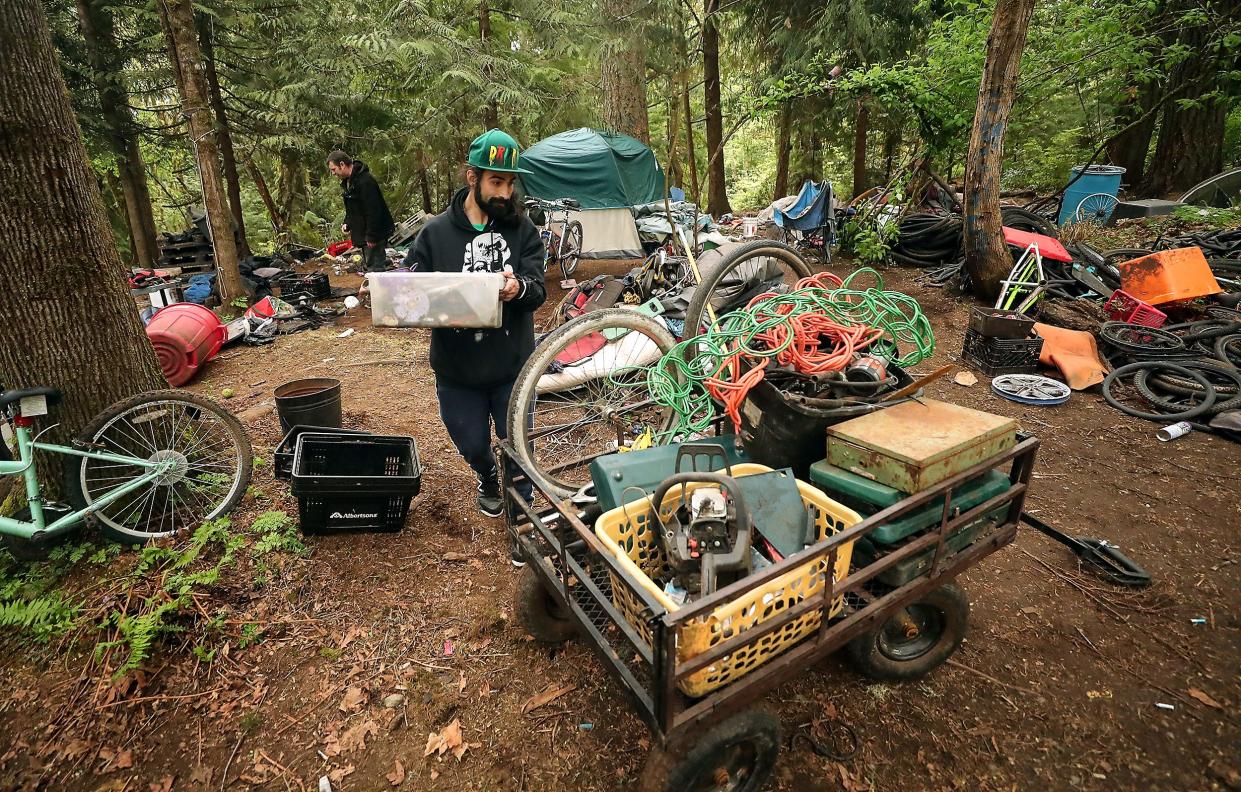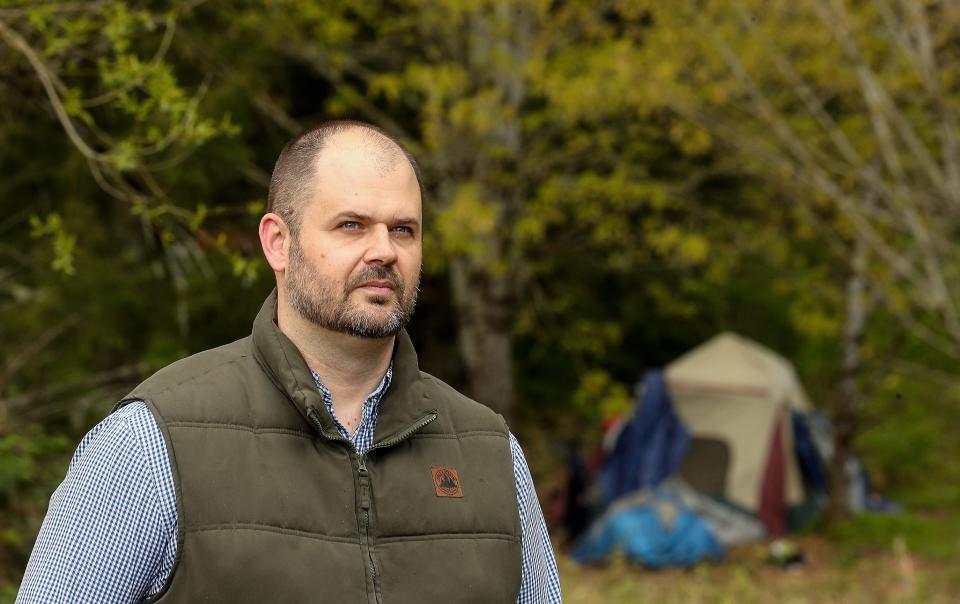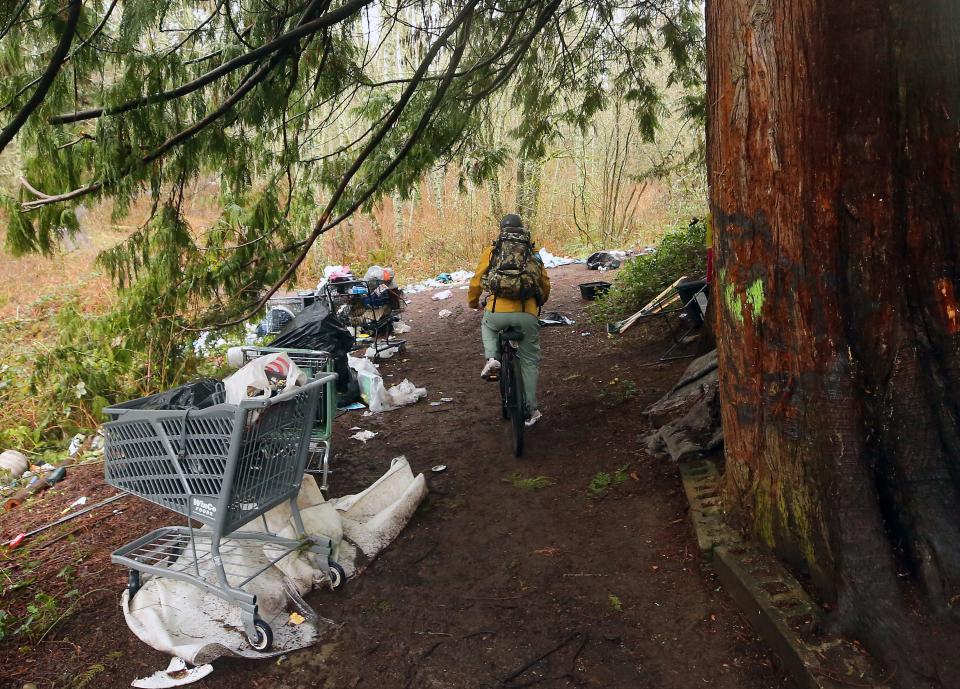Connecting homeless campers with services and shelter takes time, statistics show

Despite hundreds of site visits by homelessness outreach workers made in Kitsap County and Bremerton during 2023 and the clearing of several high-visibility congregate encampments, the persistent issue of homeless encampments and finding housing for the individuals in them persists countywide, according to recent data.
Recently released statistics collected in two different reports – the Kitsap County HEART program’s year-end review and the Kitsap County Point in Time count – give an overview of the state of homelessness and homelessness outreach in the greater Kitsap County and provide insight on the persistent struggle to shelter some of the county's most vulnerable individuals.
The 2024 Point in Time count lays out demographic data on the county’s 255 homeless individuals, revealing some root causes of homelessness for the 107 households surveyed in January. Leading those statistics, 57% said health and mental health issues contributed to their unsheltered status, an 11% rise from last year’s data; 43% said housing affordability contributed; 38% said job loss contributed and 36% said eviction and loss of housing contributed, an 8% increase.
Carl Borg, Housing and Homelessness Division program manager for Kitsap County and HEART advisory team member, pointed toward a doubling in statewide eviction filings, resulting from recent expiring ARPA funds and an increase in households below United Way’s ALICE threshold. That statistics identified 32% of Kitsap County households as unable to afford the essentials that those in "Asset Limited, Income Constrained, Employed" households barely scrape by with. Borg also attributed the county’s 9% increase in unsheltered individuals reporting discharge from systems as a root cause to an increase in fentanyl, a highly addictive drug, on the streets and a 15% decrease in out-of-state homeless people in Kitsap due to a continued increases in the cost of living in the area.
Though recent numbers offer a current snapshot of homelessness in Kitsap County, a look at the statistics on HEART team's response throughout 2023 tells the story of the longer-term journey that homeless individuals and outreach workers embark on to connect with services, and the setbacks that are built into that process.

Resolving encampments, and the reasons they keep popping up
Jarrod Moran, the founding coordinator of Kitsap County's HEART team, who left the role this month, used the word “resolved” to refer to encampment clearings. Though it can be a long process, the HEART program measures its successes by not just clearing encampments, but connecting campers to shelter and services.
The HEART program’s year-end review, provided to the Kitsap Sun though not yet posted online, reports that four larger congregate encampments were cleared during 2023: Hospital Hill near St. Michael Medical Center in Silverdale, Mickleberry Road behind the Silverdale Costco, one on SE Mile Hill Drive and Alaska Avenue SE in Port Orchard, and a Silverdale RV and tent encampment.
Kitsap County Sheriff’s Office deputy David Wolner expanded on the data, reporting that 97 encampments, whether there were one or many campers, have been cleared in the last two years and that there are only five or six active encampments in areas that he responds to with HEART team members, which excludes the city boundaries of Bremerton and Port Orchard. Wolner tracks all the encampments he responds to with pins and labels on Google Maps for his own reference, but he doesn’t record the dates they were cleared.
None of the current encampments are on county property, where HEART has jurisdiction, and one is on private property, along Greaves Way in Silverdale, where a property owner who once offered sanitation and garbage services to campers is working to evict the squatters, Borg said. There is another encampment on federally-owned property, Wolner added. HEART can’t remove campers from private property unless the owner permits – unless that owner has provided a semblance of amenities, that is.
“My goal is to get the whole community healthy,” Wolner said. “It makes me really happy to go out in the parks and see that they're clean and there are no tents around and kids can play in them, and it also makes me happy to see that people that we've been working with for ages have finally accepted treatment.”
To close an encampment, the HEART advisory team makes a judgment call following scheduled encampment visits where outreach offers services and shelter. But, a cleared encampment doesn’t mean that all campers successfully connect with services and shelter. Sometimes, they just move to a new area.
When the Hospital Hill encampment was cleared again in March 2024, Wolner, Moran and other outreach workers connected individuals with treatment at an Oxford house, bus tickets to families in other states and rooms with the Kitsap Rescue Mission, but a large amount of the approximately 25 campers resolved to relocate to other encampments, such as those along Greaves Way which have since been cleared.

“We don't want to chase them around any more than they want to be chased around,” Borg said.
Though Moran kept a name-by-name list of every homeless person he’d encountered, tracking their whereabouts, status and response to services or lack-there-of, and the services he offered, those numbers aren’t processed by the HEART program to show how many people accepted services before encampments are cleared, Borg said, adding that the team has never lost track of anyone cleared from an encampment who just moved on to another one.
The trade-off of compassion and accountability
The mission of the HEART team is to “make the encampment unnecessary,” Borg said, by offering a host of services such as shelter at the Salvation Army shelter on Bremerton's Sixth Street and specialized shelters like Pendleton Place, Benedict House, St. Vincent de Paul’s Stella Maris house and the Kitsap Rescue Mission, along with medical detox at the Kitsap Recovery Center and even a detox center in Tacoma – all of which are offered prior to clearing an encampment.
There are now 255 homeless people in Kitsap County. The report cites that 51% are in Bremerton, 18% are in Port Orchard and 17% are in Silverdale, the latter of which is where the HEART team conducts most of its outreach, as Silverdale is not its own municipality. In their year end report, the HEART team clocked 286 scheduled visits to encampments of county property and right of way.
Throughout those visits, they connected 37 people to shelter programs and helped campers complete 226 Housing Solutions Center applications. They connected 70 people with services like the REAL team, Kitsap Recovery Center’s Person In Need program, Eagle’s Wings, Adult Protective Services, the Developmental Disabilities Administration and food assistance.
In Bremerton, the newly city-contracted outreach and resource hub known as Commonstreet Consulting recorded 447 site visits in the three months since the beginning of their contract in January, making 151 “meaningful connections,” 51 connections to services, 16 to shelter or housing and plans to connect with services for 23 people, according to their report to the city council at a meeting on Wednesday. When the Kitsap Sun last checked in with Commonstreet, the organization had clocked 213 site visits by March 11.
A look at the statistics from afar shows that of 286 visits, 37 successful shelter connections is a 13% success rate, and 70 service connections is 24%, but some outreach workers estimate that it takes 12 contacts with an individual before they will accept services, Wolner said. That number is a ballpark estimate for Wolner, but it changes depending on each individual person.
He also added that although Moran’s list is updated quarterly, “it's hard to track how many people have accepted services where they've accepted them and then where they are now.”
Over the two years he's been working this position, Wolner said he’s developed enough rapport with campers that they will come up to his vehicle and shake hands when they used to avoid contact altogether. But still, many of those same people are living unsheltered and refuse to accept services.
“The majority of people that we have left out in the encampments right now are the people that are refusing services,” Wolner said.
“It's not a surprise, it's more frustration” when campers refuse, Borg said, using the Hospital Hill encampment as an example. “(HEART) has worked with them for so long and…if everybody would have accepted services that were offered services, then there would not have been anybody left at Hospital Hill.”
There are a multitude of reasons why campers don’t accept services. Among them, are mental health barriers including schizophrenia and anxiety, having pets that aren’t allowed in shelters, addiction issues, fear for safety and comfort in a congregate setting and simply not wanting to have to comply with rules and structure, Wolner said.
“A lot of times, they haven't hit that rock-bottom point yet and they need that,” Borg added. “They just have to feel ready to take control of their life.”
There are several roadblocks that remain out of campers’ control. There are also long waitlists for any shelter program that isn’t the Salvation Army, though there is movement, Borg said, though “as far as the medical detox… if they're ready to go into a detox program, then they will find them a bed.”
Shelter programs, overworked, understaffed and undertrained, also have limitations on who they can serve, such as those with extreme medical, mental health and behavioral issues, those who have animals or even families, and those who have been banned.
“We've got some people into the crisis triage center for a weekend and try to get them stabilized… but sometimes it's hard to get people in voluntarily,” Wolner said. “Our hands are really tied in a lot of cases, unless that person is like somebody we could do a commitment on, to take them into a facility for mental health reasons.”
For Wolner, outreach takes two. Outreach workers need to offer options for services continually and also lay out what courses of action are not options, such as drug use and trespassing on county or private property. Though at the end of the day, outreach can’t make choices for anyone.
“Outreach for me is a lot like being a dad and I see these people as my family,” Wolner said. “To me, being a good parent is having compassion and accountability. If you try to raise your kids with only compassion, then they're going to run around, they're going to terrorize your house…
On the flip side, if you've only got accountability or you only rule with the stick, your kids are going to also be miserable.”
New year, new HEART coordinator
While HEART marks its second year in operation since its inception in April 2022, the program also must find a replacement for the coordinator who began the journey with them. Jarrod Moran’s last day in the office was April 15. In the meantime, Borg and Wolner are taking over his responsibilities.
“He was absolutely pivotal in what we've been doing for the last couple of years and he was a great asset. I'm really happy for him,” Wolner said. “I'm sure whoever comes to fill a spot next will be will do fantastic, but they'll have some big shoes to fill.”
The HEART coordinator position has already closed after receiving applications, though interviews have not been conducted yet, Borg said. An ideal candidate will have experience and a patient and even-keel demeanor because “it's not an easy job going out every day and working with the homeless community.”
As HEART enters its third year, its mission remains unchanged.
“Homelessness in Kitsap – it's really important to me and to us to try to tackle it and to do so in a way that isn't just a short term solution,” Wolner said. “We have very little interest in just kicking the can down the road.”
This article originally appeared on Kitsap Sun: Progress reported in 2023 Kitsap County homeless outreach statistics

